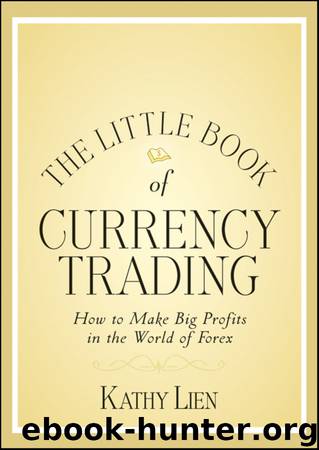The Little Book of Currency Trading by Kathy Lien

Author:Kathy Lien
Language: eng
Format: epub
Publisher: Wiley
Published: 2010-11-27T05:00:00+00:00
In the EUR/USD’s move from a high of 1.50 in November 2009 to 1.19 by June 2010, 1.45, 1.40, 1.30, 1.25, and 1.20 all looked like good value points. Eventually 1.19 was the best place to buy, but tops and bottoms are only obvious in hindsight. Yogi Berra had something to say about that.
Predicting is very hard, especially about the future.
If Sir John Templeton traded currencies, he would have probably waited until the moves became extreme and the valuation was off the charts (either under- or overvalued) before picking a top or bottom. But unless you have extremely deep pockets like Templeton, you may not be able to sit with a trade and wait for the currency to finally turn around. Most contrarians like Templeton and even some traders like John Paulson, who started to position for a subprime crisis in 2006, have had to sit with their losing positions for weeks, months, and sometimes years on the hope that they will capture most of their profits in one single period of collapse. Paulson made billions doing just that, but beneath the glamour, he fought against significant skepticism from his peers who believed that it was too dangerous to bank the entire fund on one single bet that would be difficult to unwind. Eventually Paulson’s bet paid off handsomely but not until a year later.
Most currency traders simply do not have the luxury of deep pockets and time. Forex brokers offer as much as 50 to 1 leverage, and even on a very modest 10 to 1 leverage, a mere 10 percent negative move will wipe out the entire account. Paulson believed that his investors would be willing to lose 8 percent a year on mortgage insurance for the opportunity to earn a lot more. However, 8 percent for a regular currency speculator on a 10 to 1 lever factor can be debilitating.
So how can you tell when a currency is trending? There are many different ways to determine when a currency is in trend. One of the most popular is to use a combination of the Average Directional Index (ADX) and moving averages. The ADX is a fancy indicator created by an incredibly intelligent man named J. Welles Wilder and is used to evaluate the strength of a trend. When the ADX reading is greater than 25 and pointing upward, it signals that the currency pair is in trend and the trend is strengthening. If the ADX is falling, it usually implies that the prior trend is exhausting and by the time it dips back below 25, the currency pair is most likely range trading. Moving averages measure the momentum of a move and are used to determine the direction of the trend. If the currency pair is trading comfortably above the moving average, then it means it is in an uptrend. If it is trading well below the moving average, then it means it is in a downtrend.
Exhibit 7.2 shows a weekly chart of the EUR/USD and how
Download
This site does not store any files on its server. We only index and link to content provided by other sites. Please contact the content providers to delete copyright contents if any and email us, we'll remove relevant links or contents immediately.
The Meaning of the Library by unknow(2396)
Six Billion Shoppers by Porter Erisman(2229)
Why Nations Fail: The Origins of Power, Prosperity, and Poverty by Daron Acemoglu & James Robinson(2182)
No Time to Say Goodbye(2002)
Red Notice by Bill Browder(1935)
The Economist [T6, 22 Thg9 2017] by The Economist(1845)
Currency Trading For Dummies by Brian Dolan(1793)
Thank You for Being Late by Thomas L. Friedman(1681)
Bitcoin: The Ultimate Guide to the World of Bitcoin, Bitcoin Mining, Bitcoin Investing, Blockchain Technology, Cryptocurrency (2nd Edition) by Ikuya Takashima(1617)
Amazon FBA: Amazon FBA Blackbook: Everything You Need To Know to Start Your Amazon Business Empire (Amazon Empire, FBA Mastery) by John Fisher(1497)
Coffee: From Bean to Barista by Robert W. Thurston(1423)
The Future Is Asian by Parag Khanna(1402)
The Great Economists by Linda Yueh(1394)
Capitalism Without Capital: The Rise of the Intangible Economy by Jonathan Haskel(1342)
Pocket World in Figures 2018 by The Economist(1329)
How Money Got Free: Bitcoin and the Fight for the Future of Finance by Brian Patrick Eha(1323)
Grave New World by Stephen D. King(1318)
The Sex Business by Economist(1286)
Cultural Intelligence by David C. Thomas(1205)
